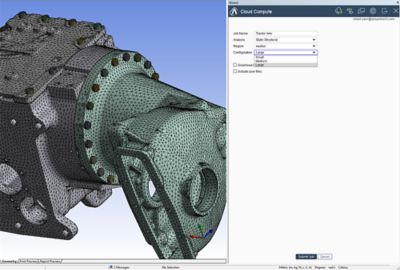Ansys Blog
February 5, 2019
Access HPC Cloud Services Without Leaving the Ansys Simulation Workflow
Simulation engineers use high-performance computing (HPC) to solve complex engineering simulations and design problems.
However, due to high upfront costs, engineering organizations may not have the budget to afford on-premise HPC.
When engineering organizations do have HPC resources, they are often overbooked.

Easy access to on-demand HPC enables
engineers to tackle large simulation
As a result, the organization’s engineers can wait a long time before their simulations are processed.
Cloud HPC has the potential to alleviate both of these challenges because of its ability to provide a large amount of computing power on-demand. The organization only pays for what its engineers use, without having to procure or manage complex IT systems.
The challenge with cloud HPC is that it is complex and time-consuming to configure. It also requires the company to create separate business relationships with cloud providers.
With the launch of Ansys Cloud, simulation engineers have access to on-demand HPC without the need to configure, or manage, a complex IT system. They also don’t need to create any additional vendor relationships.
Instead, engineers can access on-demand cloud HPC directly through Ansys Mechanical or Ansys Fluent, without leaving their desktop applications. Ansys now provides a one-vendor fully managed cloud service.
Why Engineering Organizations Need Cloud HPC
Cloud HPC increases simulation throughput, enabling engineering organizations to solve high-fidelity models and assess numerous design variables within tight project timelines.
Watch a short demo of ANSYS Cloud in action
In essence, engineering organizations have a continuous stream of product performance data to make faster, better design decisions.
“Ansys Cloud enables Hytech Ingenieria to calculate large and complicated geometries within hours, instead of days or weeks — resulting in significant time savings,” said Luis Baikauskas, process engineer at Hytech Ingeniería.
Engineering organizations embrace cloud computing because it offers agility. They can quickly respond to business opportunities without procuring or deploying additional on-premise HPC resources for peak demands.
The cloud also gives organizations the ability to focus. It enables them to concentrate on differentiating their products and winning the marketplace — not managing HPC resources. This is particularly true for small and medium-size businesses who can’t afford large capital hardware expenditures.
Bert Blocken, professor at Eindhoven University of Technology and KU Leuven said, “Ansys Cloud provides an easy-to-use option for quick access to cloud HPC directly from within Ansys applications. This is especially useful for businesses with variable simulation workloads.”
How Ansys Cloud Simplifies HPC Configurations
Engineering organizations face big challenges when they configure cloud HPC environments to solve simulations.
Menu shows that engineering organizations will have
easy access to preconfigured hardware
Cloud providers offer a powerful box of services, but it’s up to the engineering organization to configure them. This can be difficult and time-consuming for organizations that don’t have HPC expertise.
However, Ansys Cloud has greatly simplified access to on-demand, pay-as-you-go HPC through Microsoft Azure. Everything is preconfigured and accessible within Mechanical and Fluent. Just select the closest data center that meets privacy requirements and hit “submit.”
Since the Ansys Cloud is purpose-built for Ansys solvers, engineering organizations are assured they will get the best performance possible.
Ansys Cloud’s Web Based Portal
Engineers have a lot of ways to monitor and manage their simulation jobs in the Ansys Cloud.
First, they can access their jobs’ progress and convergence charts within Fluent and Mechanical.
Second, they can free up those Ansys licenses, for other engineers, by monitoring their jobs in the Ansys Cloud portal.
Check a simulation job’s status
on a cell phone
This portal is accessible on any device through a web browser.
The portal gives engineers a dashboard view of:
- Simulation jobs.
- Hardware usage.
- Software usage.
The portal also offers tools to view 3D results — even on a mobile device. This means engineers don’t have to download data from the cloud to validate or gain insights from their simulations. When data is downloaded, the results are automatically integrated into the Ansys project as if it were computed on the desktop.
The portal also offers basic collaboration capabilities: Engineers can easily share simulation files with their colleagues or communicate with Ansys support.
“Ansys Cloud is intuitive to use and integrates seamlessly into our Fluent workflow,” said Adam Kline-Schoder, flight data analyst at Altaeros. “By using an internet browser to check job status, view convergence plots, and pause or stop jobs we had more control of our simulations than with other cloud services and this made our computational work much more efficient.”
How Cloud HPC is Changing Product Development
The demand for cloud HPC services is growing in the simulation world.
Video shows how Blocken’s team uses the ANSYS Cloud to run CFD simulations
to research the aerodynamics of professional cycling
A survey conducted by IDG shows that the average IT environment is 48 percent in the cloud. This is expected to grow to 69 percent in 18 months.
The adoption of engineering simulation in the cloud is driven by shrinking product development schedules, lean budgets and pervasive engineering simulation throughout the product lifecycle.
“Altaeros depends on the fast turnaround of dozens of operating points on high-fidelity Ansys Fluent models to support flight dynamics and mechanical design needs,” said Jon Everitt, principal aerodynamicist at Altaeros. “Cloud computing accelerates time to results, and the built-in interface to Microsoft Azure within the Ansys tools presents a compelling case for its adoption.”

